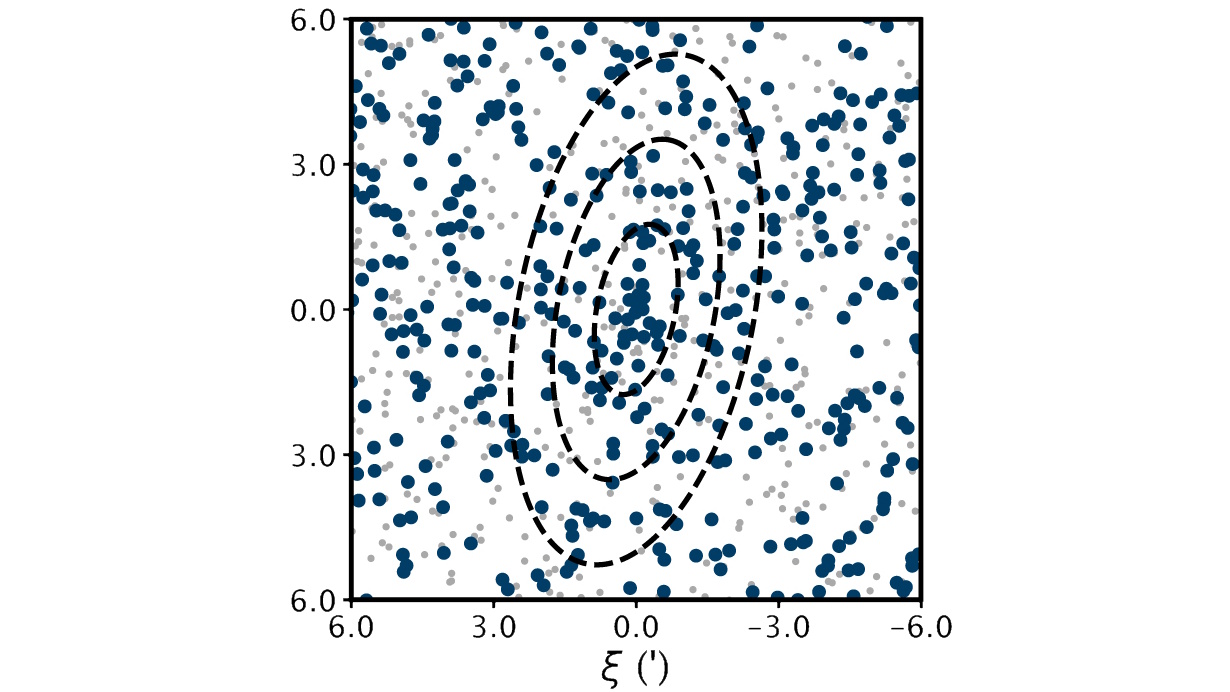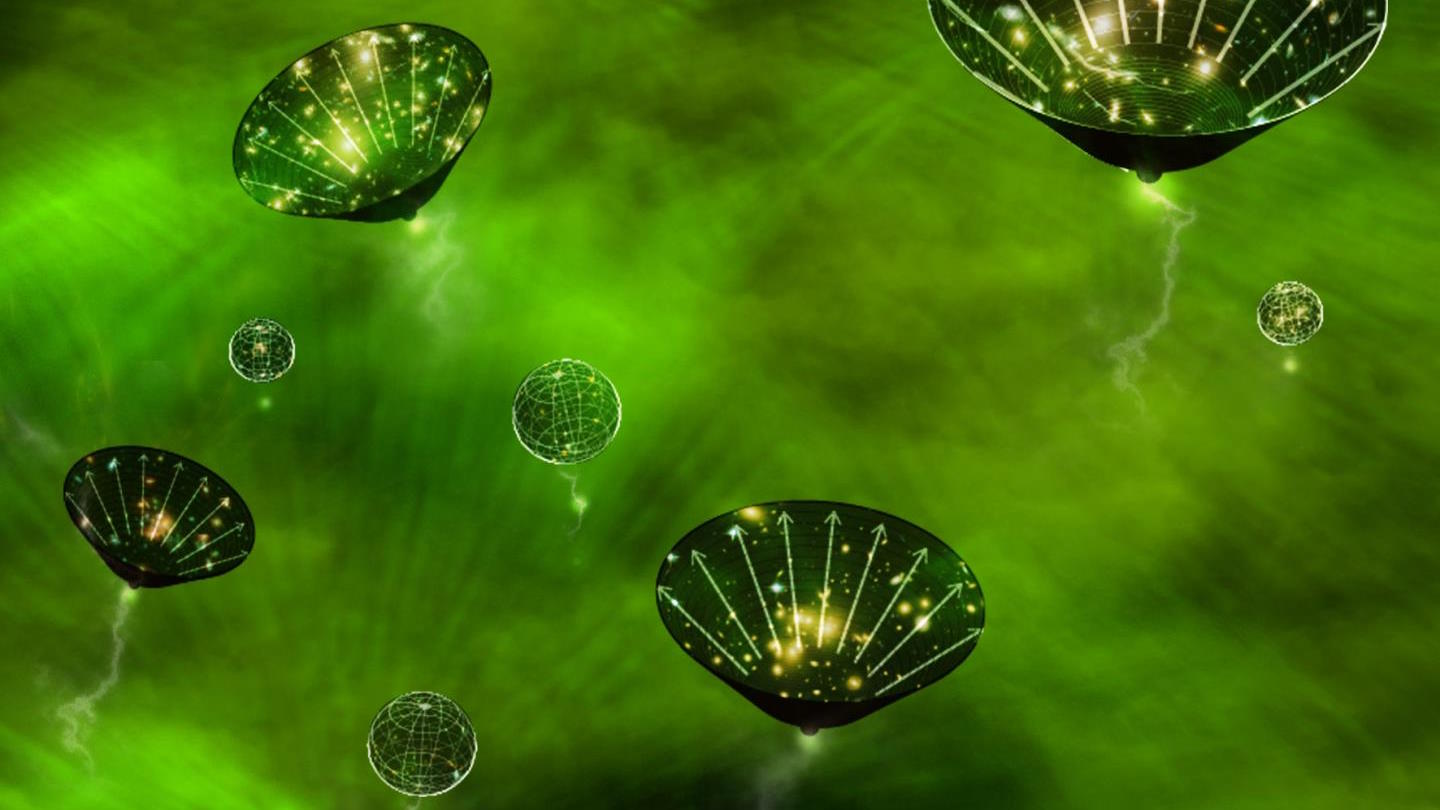Messier Monday: A Southern Sky Surprise, M80
And the unheralded astronomer who brought its secrets to light.
“In a word, in the eyes of a giant, to whom our Suns were what our atoms are to us, the Milky Way would only look like a bubble of gas.” -Henri Poincaré
Of the 110 deep-sky objects that make up the Messier catalogue, the first accurate and comprehensive set of the closest, brightest fixed-but-extended objects visible from mid-northern latitudes, a full 29 of them are globular clusters: collections of hundreds of thousands of stars within a radius typically under 100 light-years. But what you might not realize is that of these 29, only 8 of them are located north of the celestial equator; a full 21 of them are actually better viewed from the southern hemisphere!
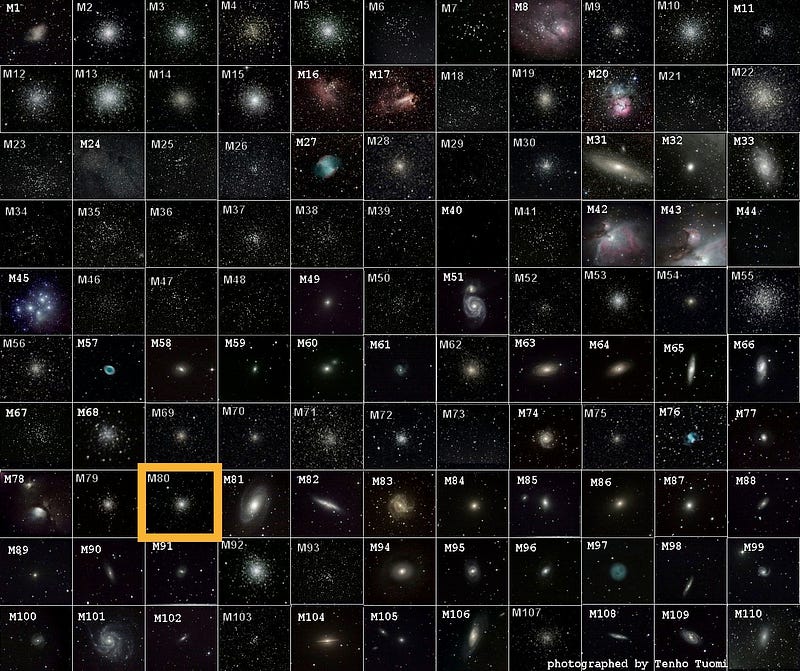
Much of the foundational work done on these southerly globular clusters was performed in the 1920s and 1930s by Helen Sawyer (later, Helen Sawyer Hogg), who was one of the first astronomers to travel around the world to obtain better observing locales to view deep-sky objects. The Shapley-Sawyer concentration class, which is how we classify the stellar density profiles of globular clusters (on a scale from I-to-XII), is co-named after her for her pioneering work.
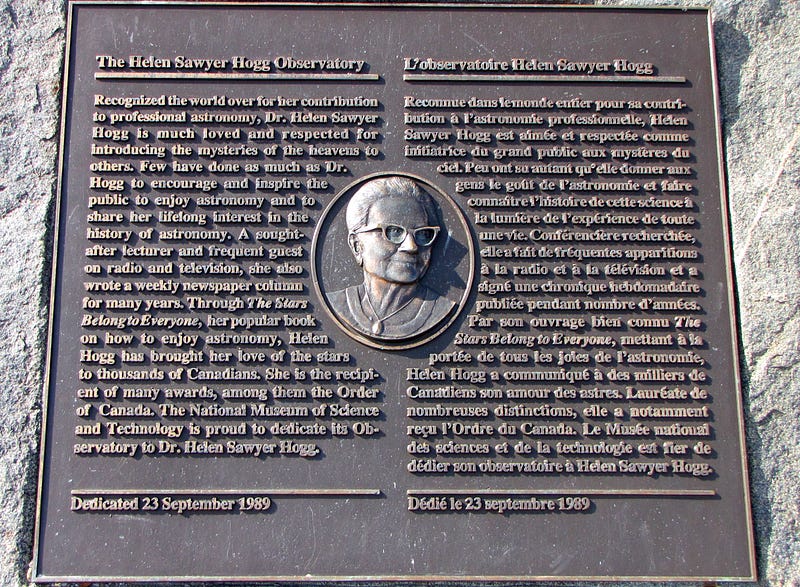
In addition to cataloguing more than 1,000 variable stars in globular clusters, she also published a very important paper on the bright nova of 1860, which was the first nova ever observed in a globular cluster. That cluster happens to be Messier 80, which is today’s object! From anywhere south of the arctic circle, this is an object you can find tonight; here’s how.
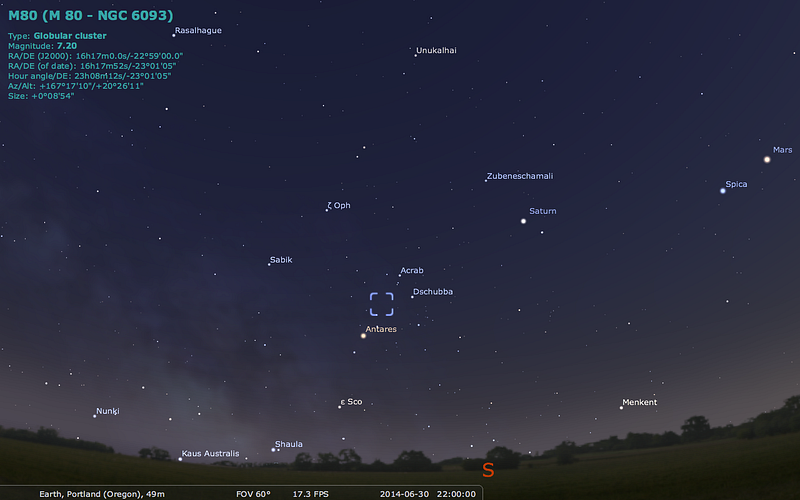
The summer constellation Scorpius can be found in the southern part of the skies from mid-northern latitudes tonight, heralded by its brightest member Antares, the sixteenth brightest star in the entire sky. North and just a bit east of Antares lies the easily visible naked-eye star Acrab, which itself is actually a sextuple system. In between Antares and Acrab are a number of prominent stars, but if you look mid-way between them, you’ll be well on your way to encountering Messier 80.
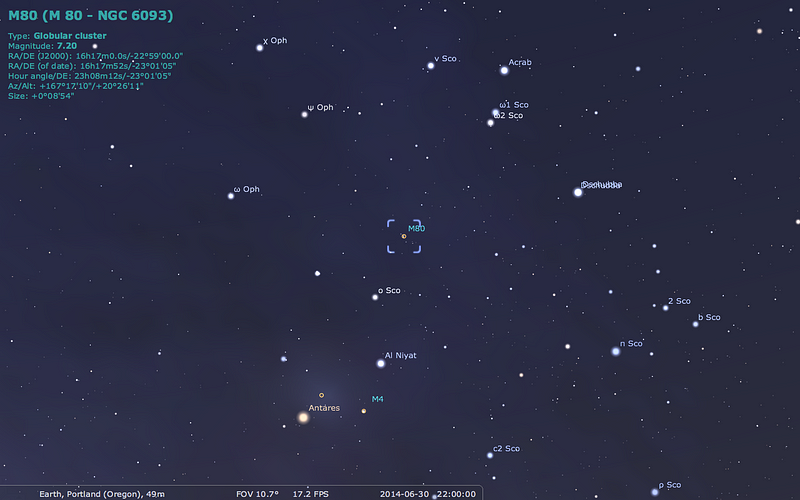
Along the imaginary line connecting Antares to Acrab, there’s a star about a third of the way along: ο Scorpii, that’s easy to find in even reasonably light-polluted skies. A little under 2° farther along, you’ll come to Messier 80, a brilliant sight through binoculars or a telescope.
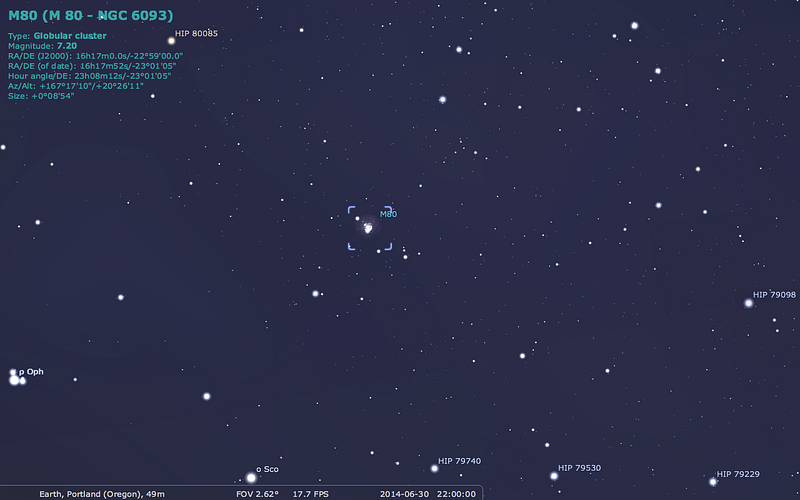
First discovered by Messier himself back in 1781, he described it as such:
Nebula without star, in Scorpius […] this nebula is round, the center brilliant, & it resembles the nucleus of a small Comet, surrounded with nebulosity.
Like many of the “round nebulae” that Messier identified, this is actually a collection of hundreds of thousands of stars compactly located tens of thousands of light-years away.

This one, in particular, has the mass of slightly over half-a-million Suns, is 32,600 light-years away and is only around 48 light-years in radius. Most globular clusters are significantly more “metal-poor” than our Solar System, meaning that there are fewer heavy elements, or elements beyond hydrogen and helium in the Periodic Table. Messier 80 is pretty typical for that, with only about 3.4% the heavy elements found in our Sun.
In addition to these “standard” properties, there are a large number of radio pulsars — pulsing neutron stars pointed right at us — found inside.
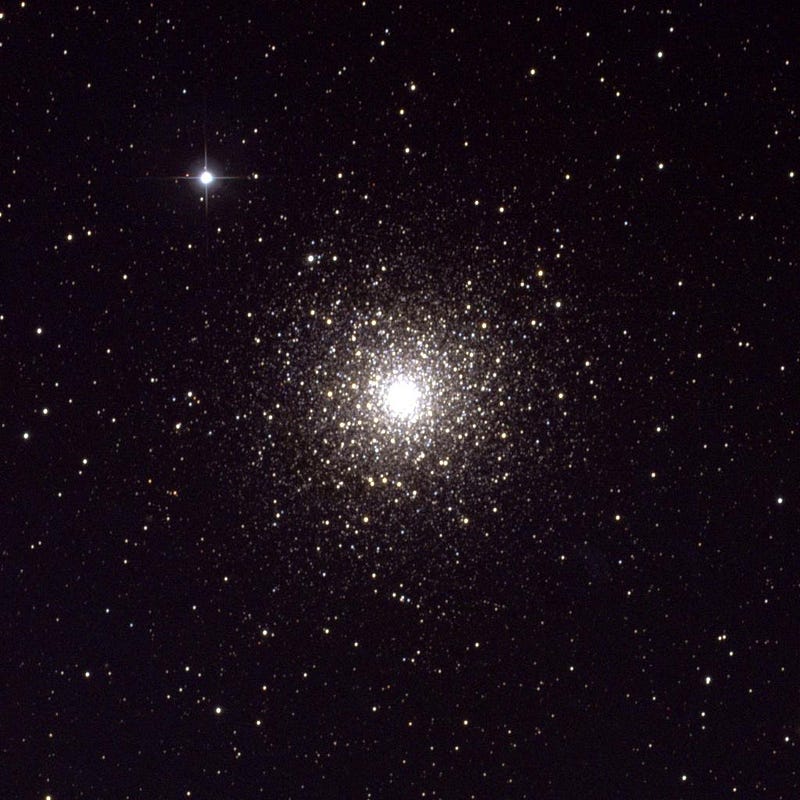
Globular clusters, as we mentioned earlier, come in all sorts of cluster densities, with class I clusters having the strongest central concentration of stars and class XII being the most diffuse. M80 is definitely on the more concentrated end, being a class II cluster. What this means is that the stellar density as we move very close to the cluster’s center is significantly higher than average, providing a much higher density of binary stars and a much larger probability of stellar mergers.
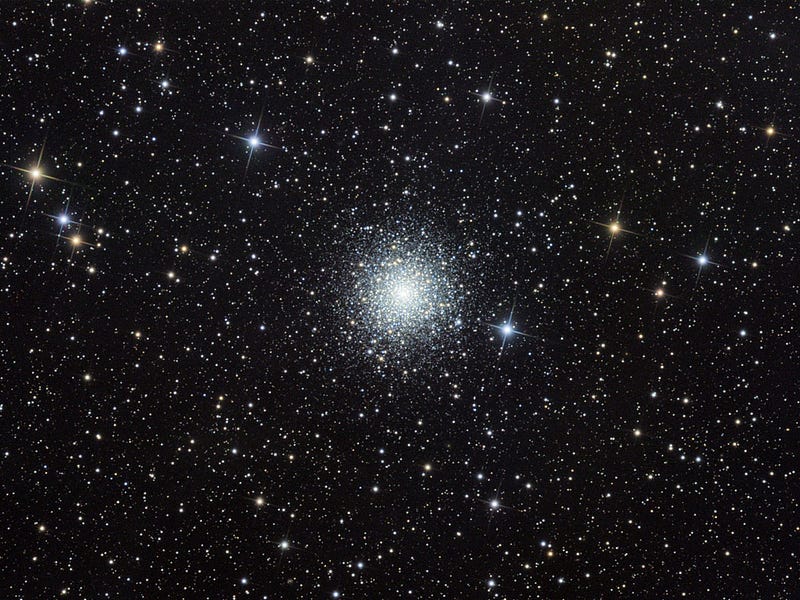
In fact, this latter property must be true, as we see an inordinately large number of blue straggler stars inside: stars that look deceptively young, blue and high-mass because they were formed by the recent merger of two older, lower mass stars! Out of all the globular cluster cores investigated by the Hubble Space Telescope, Messier 80 contains almost twice as many blue straggler stars as any other, even when compared with clusters that contain ten times as many stars!
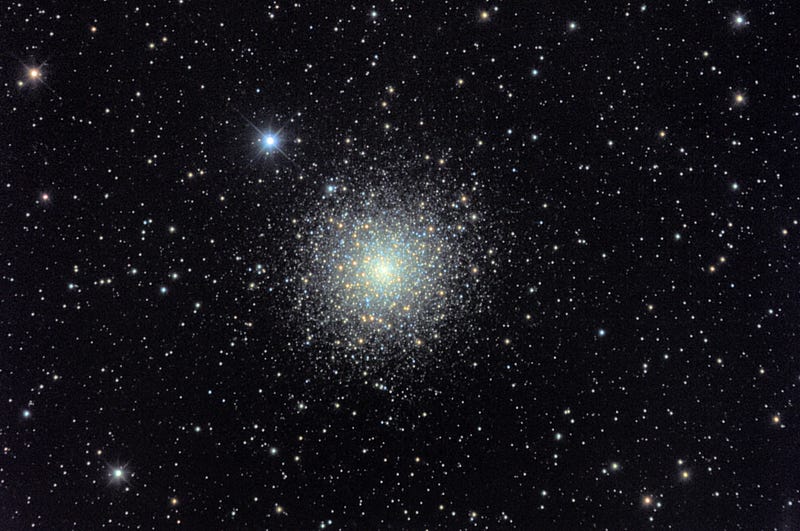
And finally, the 1860 nova that went off in this cluster — known as T Scorpii — was one of the most remarkable events ever seen through a telescope. Discovered by Arthur von Auwers, this nova reached a peak brightness of magnitude +7.0, briefly outshining the entire cluster. In absolute terms, at its peak, the nova shone with a brightness more than 200,000 times larger than our Sun! Given the abundance of white dwarfs inside a globular cluster like this, it’s only a matter of time before a white dwarf-white dwarf merger-or-collision happens, which will no doubt trigger a Type Ia supernova. Given the high capture rate of the stars in this globular’s core, it’s one of our best bets as we wait for the first-ever supernova to be observed in a globular cluster! (And we’ve looked.)
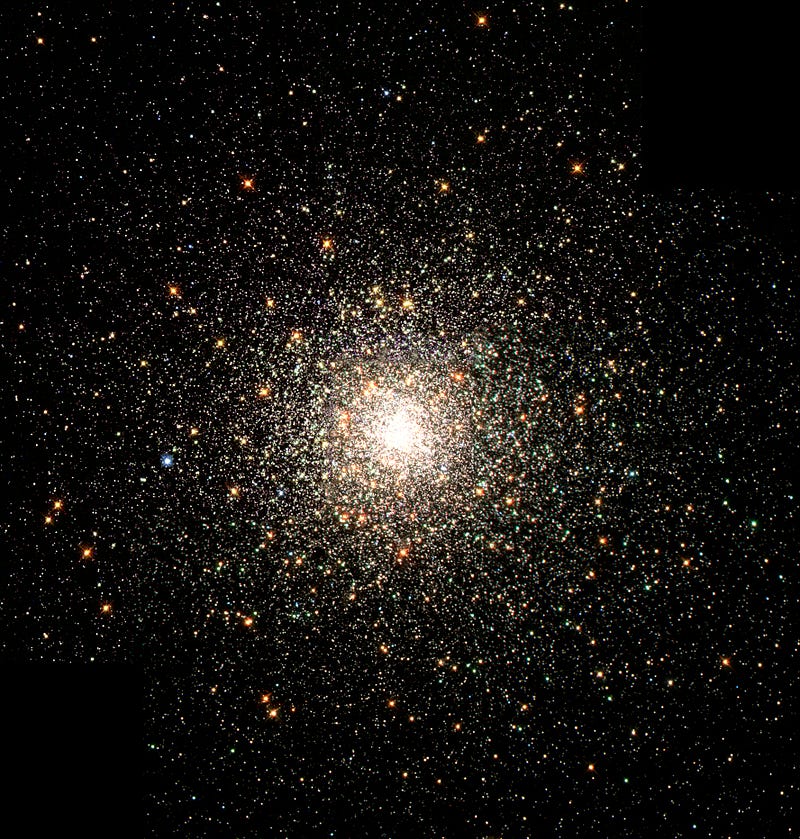
So have a look for Messier 80 in the skies tonight, and if you find it, think of Helen Sawyer Hogg and her tremendous contributions to our understanding of these objects. In the meantime, as a companion to the Hubble image, shown above, enjoy a full-resolution slice through the very core of this globular, and make note of the blue stragglers (and the red giants, many of which are evolved blue stragglers) when you see them!

And just for comparison, even though he doesn’t have a Hubble telescope, I do have to say that Jim Misti did an amazing job capturing the full glory of this cluster in its entirety, something Hubble can’t do thanks to its narrower field of view. Check it — along with the blue stragglers and the red giants — out!
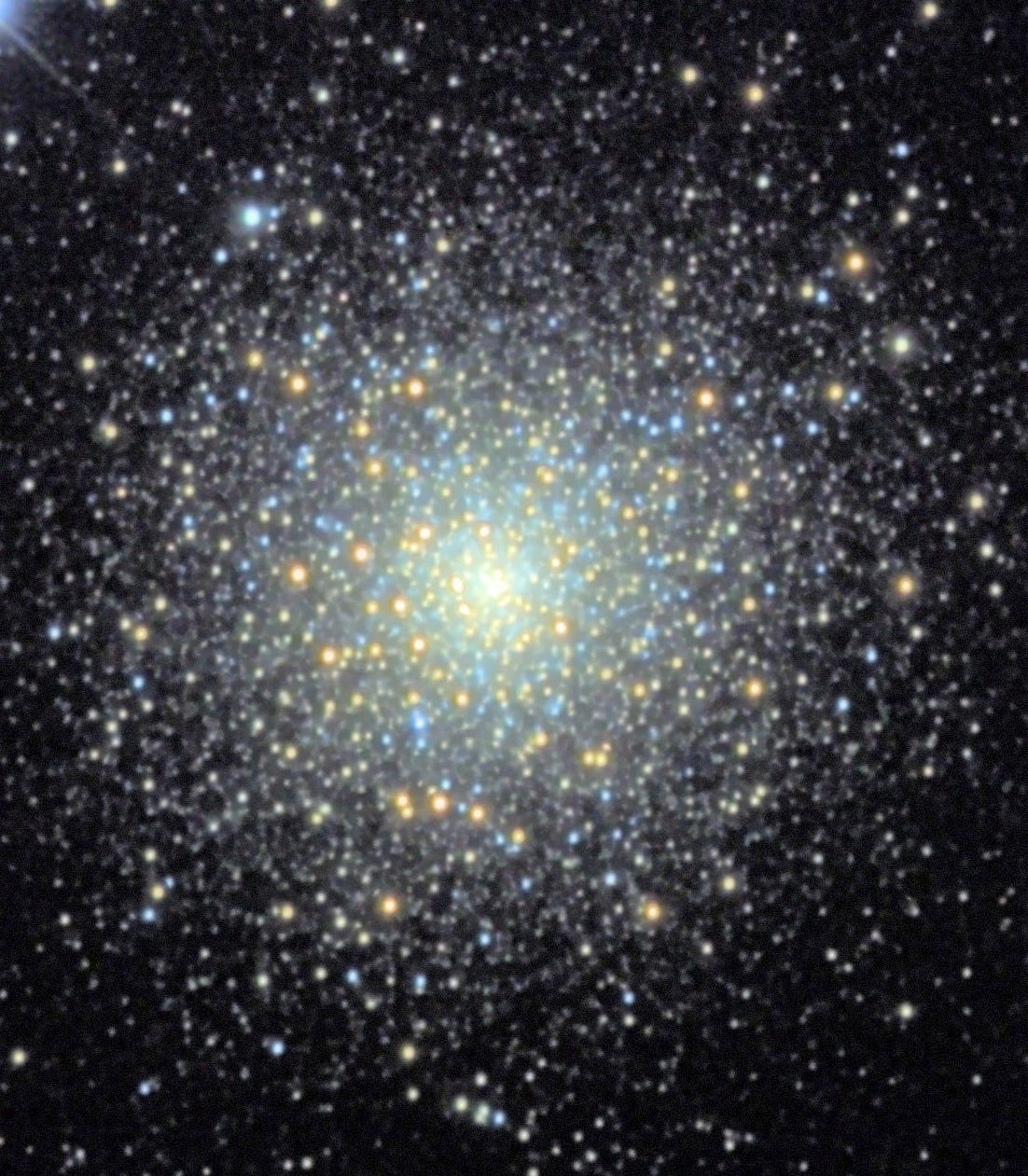
With that, we’ve made it through a whopping 89 of the 110 Messier objects now; have a look back at all our previous Messier Mondays here:
- M1, The Crab Nebula: October 22, 2012
- M2, Messier’s First Globular Cluster: June 17, 2013
- M3, Messier’s First Original Discovery: February 17, 2014
- M4, A Cinco de Mayo Special: May 5, 2014
- M5, A Hyper-Smooth Globular Cluster: May 20, 2013
- M7, The Most Southerly Messier Object: July 8, 2013
- M8, The Lagoon Nebula: November 5, 2012
- M10, A Perfect Ten on the Celestial Equator: May 12, 2014
- M11, The Wild Duck Cluster: September 9, 2013
- M12, The Top-Heavy Gumball Globular: August 26, 2013
- M13, The Great Globular Cluster in Hercules: December 31, 2012
- M14, The Overlooked Globular: June 9, 2014
- M15, An Ancient Globular Cluster: November 12, 2012
- M18, A Well-Hidden, Young Star Cluster: August 5, 2013
- M20, The Youngest Star-Forming Region, The Trifid Nebula: May 6, 2013
- M21, A Baby Open Cluster in the Galactic Plane: June 24, 2013
- M25, A Dusty Open Cluster for Everyone: April 8, 2013
- M27, The Dumbbell Nebula: June 23, 2014
- M29, A Young Open Cluster in the Summer Triangle: June 3, 2013
- M30, A Straggling Globular Cluster: November 26, 2012
- M31, Andromeda, the Object that Opened Up the Universe: September 2, 2013
- M32, The Smallest Messier Galaxy: November 4, 2013
- M33, The Triangulum Galaxy: February 25, 2013
- M34, A Bright, Close Delight of the Winter Skies: October 14, 2013
- M36, A High-Flying Cluster in the Winter Skies: November 18, 2013
- M37, A Rich Open Star Cluster: December 3, 2012
- M38, A Real-Life Pi-in-the-Sky Cluster: April 29, 2013
- M39, The Closest Messier Original: November 11, 2013
- M40, Messier’s Greatest Mistake: April 1, 2013
- M41, The Dog Star’s Secret Neighbor: January 7, 2013
- M42, The Great Orion Nebula: February 3, 2014
- M44, The Beehive Cluster / Praesepe: December 24, 2012
- M45, The Pleiades: October 29, 2012
- M46, The ‘Little Sister’ Cluster: December 23, 2013
- M47, A Big, Blue, Bright Baby Cluster: December 16, 2013
- M48, A Lost-and-Found Star Cluster: February 11, 2013
- M49, Virgo’s Brightest Galaxy: March 3, 2014
- M50, Brilliant Stars for a Winter’s Night: December 2, 2013
- M51, The Whirlpool Galaxy: April 15th, 2013
- M52, A Star Cluster on the Bubble: March 4, 2013
- M53, The Most Northern Galactic Globular: February 18, 2013
- M56, The Methuselah of Messier Objects: August 12, 2013
- M57, The Ring Nebula: July 1, 2013
- M58, The Farthest Messier Object (for now): April 7, 2014
- M59, An Elliptical Rotating Wrongly: April 28, 2014
- M60, The Gateway Galaxy to Virgo: February 4, 2013
- M61, A Star-Forming Spiral: April 14, 2014
- M63, The Sunflower Galaxy: January 6, 2014
- M64, The Black Eye Galaxy: February 24, 2014
- M65, The First Messier Supernova of 2013: March 25, 2013
- M66, The King of the Leo Triplet: January 27, 2014
- M67, Messier’s Oldest Open Cluster: January 14, 2013
- M68, The Wrong-Way Globular Cluster: March 17, 2014
- M71, A Very Unusual Globular Cluster: July 15, 2013
- M72, A Diffuse, Distant Globular at the End-of-the-Marathon: March 18, 2013
- M73, A Four-Star Controversy Resolved: October 21, 2013
- M74, The Phantom Galaxy at the Beginning-of-the-Marathon: March 11, 2013
- M75, The Most Concentrated Messier Globular: September 23, 2013
- M77, A Secretly Active Spiral Galaxy: October 7, 2013
- M78, A Reflection Nebula: December 10, 2012
- M79, A Cluster Beyond Our Galaxy: November 25, 2013
- M80, A Southern Sky Surprise: June 30, 2014
- M81, Bode’s Galaxy: November 19, 2012
- M82, The Cigar Galaxy: May 13, 2013
- M83, The Southern Pinwheel Galaxy, January 21, 2013
- M84, The Galaxy at the Head-of-the-Chain, May 26, 2014
- M85, The Most Northern Member of the Virgo Cluster, February 10, 2014
- M86, The Most Blueshifted Messier Object, June 10, 2013
- M87, The Biggest One of them All, March 31, 2014
- M88, A Perfectly Calm Spiral in a Gravitational Storm, March 24, 2014
- M90, The Better-You-Look, The Better-It-Gets Galaxy, May 19, 2014
- M91, A Spectacular Solstice Spiral, June 16, 2014
- M92, The Second Greatest Globular in Hercules, April 22, 2013
- M93, Messier’s Last Original Open Cluster, January 13, 2014
- M94, A double-ringed mystery galaxy, August 19, 2013
- M95, A Barred Spiral Eye Gazing At Us, January 20, 2014
- M96, A Galactic Highlight to Ring in the New Year, December 30, 2013
- M97, The Owl Nebula, January 28, 2013
- M98, A Spiral Sliver Headed Our Way, March 10, 2014
- M99, The Great Pinwheel of Virgo, July 29, 2013
- M101, The Pinwheel Galaxy, October 28, 2013
- M102, A Great Galactic Controversy: December 17, 2012
- M103, The Last ‘Original’ Object: September 16, 2013
- M104, The Sombrero Galaxy: May 27, 2013
- M105, A Most Unusual Elliptical: April 21, 2014
- M106, A Spiral with an Active Black Hole: December 9, 2013
- M107, The Globular that Almost Didn’t Make it: June 2, 2014
- M108, A Galactic Sliver in the Big Dipper: July 22, 2013
- M109, The Farthest Messier Spiral: September 30, 2013
And come back next week for another deep-sky wonder as the summer constellations come into view in full-swing; even a waxing gibbous Moon can’t stop us from exploring the deep sky wonders here on Messier Monday!
Enjoyed this? Leave a comment on the Starts With A Bang forum at Scienceblogs!


